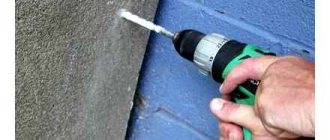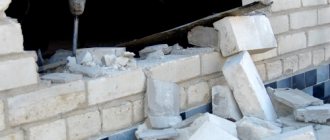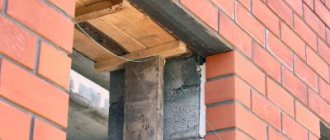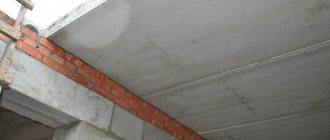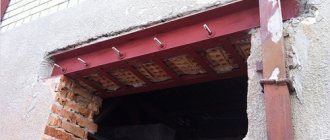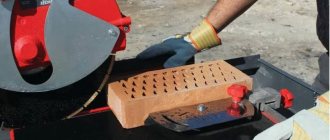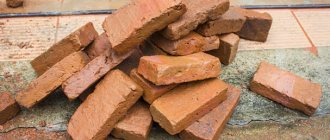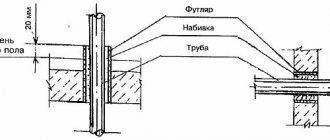Hardware used to secure objects to concrete also fits well into brick. They differ in many ways, and each of them must be taken into account when choosing the option that is suitable for a particular case.
According to the shape of the head
This classification implies the following types of self-tapping screws for concrete and brick:
- Products with a hidden conical head complemented by cross-shaped pins;
The specific head configuration depends on the selected mounting method. Thus, edges and studs are installed in a pre-prepared hole filled with sealing material. Other hardware does not require preparation, since it is fixed on its own without or with drilling.
The choice of fastening also depends on the density of the wall. A concrete screw with a hex head does not require pre-drilling a hole, only if the concrete is light enough, not dense.
By type of protective coating
Self-tapping screws are made of durable steel and covered with a protective layer that prevents corrosion. Such protective coatings differ in composition and scope of application:
- Black screws are coated with an oxidized layer. They are used exclusively at normal, not too high levels of humidity.
- The yellow color of the hardware means a protective copper layer; it also requires a normal level of humidity and is used indoors.
- The silver protective layer is made of zinc. Such hardware is universal; they are suitable for securing objects outdoors and inside buildings.
By the color of the screws it is easy to determine what protective layer it is covered with and for what conditions of use it is intended.
To size
Another sign by which self-tapping screws for concrete is size.
Self-tapping screws for concrete vary widely in size: the table above indicates the main types.
According to thread characteristics
The thread differs in pitch and appearance, and these features must be taken into account when choosing fasteners for working with concrete. The following thread types are distinguished:
- Screw.
A helical groove runs along the entire rod. This is a classic option that is suitable for installation in light and heavy concrete. If the wall is too dense and hard, then dowels are used to securely fasten the hardware. First, they are driven into the holes, and then self-tapping screws are placed inside them.
Deformable polymer dowels
Now dozens of models of fasteners are produced, which, after screwing a self-tapping screw into it, radically changes its original shape in the wall. Special deformable zones can simply expand in the hollow material, not only to the sides (frame structure), but also, for example, in a spiral. Particularly noteworthy are the twisting fastener options, which form a so-called “tangle” in the deformable area.
By the way, they are universal, that is, they function equally well on both hollow and porous walls.
Not long ago, innovative two-component dowels with universal action appeared, which simultaneously work through friction, folding and twisting.
When choosing a deformable dowel, like other types of fasteners, you need to “guess” the length. The expanding part must fall into the right place where it will work. There must be a clear idea of the structure of the wall, or you will have to use the selection method.
First things first, first things tools
nails, screws, rivets, anchors
Reliable fastening of the structure is a guarantee that it will last a long time without requiring additional repairs. In this regard, it is very important to choose reliable tools and fastening elements. And this choice must be approached with all responsibility.
You will need special tools . An impact drill is best.
You can also choose a regular drill, to which a pobedit tip is selected. But in this case the work will be more complicated. In terms of cost, this will result in approximately the following figures: from 800 rubles for the tool itself and from 40 to 50 rubles in addition for the drill. Running sizes are considered to be 6 and 8 mm diameters.
The list of materials that such tools can work with is extensive. Their choice will depend on the future load of the suspended structure. The most popular are the following:
- self-tapping screws for bricks;
- dowels (will help withstand heavy loads);
- anchors (capable of holding very heavy things);
- rivets (for delicate glass shelves);
- corners (for small cabinets and shelves);
- regular nails combined with all the others.
It is also important to consider what kind of product is used for laying the surface - it can be either solid or hollow. The types and grades of this product will also tell you how reliable the self-tapping screws used for bricks are.
Requirements for the location of screws
Before installing the screws, mark the locations for their installation. Do this by following these rules:
- the distance from the edge to the first fastening point is greater than two screw lengths;
- in bases made of porous concrete, dowels (screws) with a length of 60 mm are used, in bases made of dense concrete – from 40 mm.
- anchors are located at a distance of 120 mm from one another in cellular concrete or 150 mm in dense concrete.
- The hardware is screwed in so that cold bridges do not form between them.
the hole is deeper than the length of the screw;
Features of choice
To choose the right screw for concrete, you need to evaluate the load, working conditions, purpose and price of hardware:
- Calculate the load on the dowel. The weaker the material and the greater the weight accepted, the longer the fastener should be. Small objects up to 1 kg can be fixed with a rod with dimensions 3x16mm. Loads of up to 5 kg are supported by 3x25 mm dowels in porous bases and 3x20 mm dowels in dense bases. For fastening structures up to 20 kg, concrete screws with a diameter of 4 mm and a length of 20-70 mm are suitable. A dowel with a cross section of 5-6 mm is used to take weight up to 50 kg, 8-10 mm - up to 100 kg.
- To operate fasteners in conditions of high humidity, choose galvanized or stainless steel screws. They are resistant to corrosion and are not destroyed by water. Black oxidized or phosphated ones are used in dry rooms.
- The varied design of hardware heads allows you to select screws for any interior or hide them under decorative overlays.
- On average, the price of 3.5x16 mm products ranges from 120 to 200 rubles. for 100 pieces, 4x25 - 170 rubles, 7.5x202 mm - 1200 rubles. The cost varies greatly depending on the quality of the steel, coating option, and country of manufacture.
Self-tapping screws for concrete are used in construction and repair for the installation of parts, components, and equipment. They are used for finishing rooms, fastening hanging furniture, and interior elements. It is important to choose the right screws in accordance with the purpose, operating conditions and load-bearing capacity of the fastener.
Self-tapping screws for concrete without drilling - overview of types and instructions for use
Each of us at least sometimes has to drill into concrete walls and other hard materials. Installation of any fastening element is carried out according to a single method: hole - cleaning the channel - fitting a sleeve (dowel, wooden "chop") - screwing in a self-tapping screw (screw). But is this always possible?
Anyone who has worked with reinforced concrete structures knows how, at the most “inopportune” moment, a drill (drill) rests on something and goes no further. It's good if it's pebbles. You can crush it with a punch and continue drilling. What if a reinforcing bar gets in the way? That's right, you need to start in a different place, moving a little, and all over again.
But when preparing a “channel” for screwing a self-tapping screw into concrete, there is another difficulty. Namely – the sleeve, its diameter. After all, the drill is selected not for the fastener itself, but for it. Can it be installed everywhere? For example, when attaching door or window blocks, it often happens that the drilling is done close to the outer surface of the wall. And the thinner the “partition” between it and the hole, the more unreliable such fixation will be.
- Fastening Features
- Installation method
- Price
- Useful tips
Fastening Features
In appearance, such self-tapping screws are not much different from an ordinary screw. Although there are some specific characteristics that are determined by the purpose of the products - “for concrete without drilling”
- The material used is high-quality steel of special strength. And this is understandable, since you have to work with hard materials.
- Non-standard thread. Its configuration varies along the length of the product. Such a variable notch is called a “dowel”. It provides more reliable fixation of the self-tapping screw in concrete.
- The head is, as a rule, only with a “cross” or “asterisk”. And this is understandable, since when screwing in you will have to exert considerable effort, and ordinary slots (a slot for a flat-head screwdriver) can easily be torn off. Although there are other versions of it – turnkey hexagon, “barrel” and the like.
- Corrosion resistance. All hardware has a special coating.
- A sharp tip that easily “fits” into a dense structure (although not for all products).
- Standard diameter is 7.5 mm. And the length ranges from 50 to 200 mm.
- Reusable. This makes it possible to use such self-tapping screws for fixing temporary, removable, portable structures.
Installation method
In principle, it is the same for different concretes, the only difference is where to start.
If the material is “loose”, then it is enough to mark a point at the place where the self-tapping screw is screwed in and deepen it a little. This is easy to do with a thin cross screwdriver, an awl or something similar.
For a denser base, it is advisable to pre-drill a shallow hole to create a kind of “guide channel”. This will guarantee that the fastening element will not “lead” somewhere to the side, and it will be installed exactly perpendicular to the surface.
To securely fit the hardware, it is enough to take a 2-3 mm drill (there are some on sale for concrete). Therefore, for example, for a base made of reinforced concrete or gas silicate, the definition “without drilling” is not entirely correct. Although partially, you will still have to use a drill or hammer drill. Therefore, in such cases, it is more correct to talk about installing hardware “without a sleeve (dowel).”
Price
Size Chart
It mainly depends on the length of the screw. If a batch is purchased (and this is usually 1,000 pieces or more), then a discount is given. Both packs (100 pcs.) and “loose” are available for sale. Retail price starts from 165 rubles/piece. But this is for products from a well-known manufacturer. Although you can often find similar fasteners for 25 rubles/piece. If a significant load on the self-tapping screw is not expected, then in principle there is no difference, and the savings are obvious.
Installation Rules
To screw a self-tapping screw into concrete, ensuring a strong fixation of the structure, you must first inspect the surface itself. If the concrete is crumbling, it is advisable to make a test hole in the place where you plan to screw in the fastening device. The hole is made with a Phillips screwdriver or an awl. The resulting depression will prevent the screw from going to the side. It will be mounted clearly perpendicular to the surface.
When fixing a self-tapping screw on a sufficiently dense wall, there is no need to make a preliminary recess. The tool is immediately screwed into the wall, but this requires physical effort. You can speed up the process using a drill. If it is not there, you can use a hammer to hammer in the hardware about 1/3 , then screw it in.
Screwing in a self-tapping screw is carried out in two ways: with and without a dowel. A plastic dowel mounted in the hole provides good grip due to teeth or spikes that expand when the device is screwed in.
The dowel is chosen in the following cases:
- large loads on the screw;
- fastening to cellular blocks;
- fastening to structures subject to constant vibration.
Using an electric drill, a screwdriver with a drill or a hammer drill, drill a hole corresponding to the cross-section of the dowel and a depth of slightly more than 3-5 mm of its length. The cavity is cleaned of debris and dust, and a dowel is driven into the socket. The self-tapping screw is screwed into the seat using a screwdriver or screwdriver.
Installation of self-tapping screws without drilling:
- With basting , when a small recess is pre-drilled to provide a seat, and a screw with a herringbone thread is driven in with a hammer. The tool is no longer used again.
- According to the template. The self-tapping screw is screwed into the concrete surface through a pattern made from scraps of boards.
Before installing self-tapping screws, you need to consider the following nuances :
- the distance between the screws should be 12-15 cm;
- the length of the fastener should not exceed the thickness of the concrete;
- the greater the load, the larger the screw required;
- for lightweight concrete the minimum planting depth is 60 mm, for heavy concrete - 40 mm.
Self-tapping screws for concrete have long been successfully used in construction work, repairing equipment and parts. They are often used for fastening furniture, equipment, and various interior items. The main thing is to choose the appropriate device, taking into account its load-bearing capacity and other technical characteristics.
Main rules of fastening
correct fastening of screws
Before starting work, you need to understand some rules. They will help not to spoil the surface and carry out the correct fasteners:
- The most basic requirement that must be met when attaching something to a wall made of such material is not to spoil the mortar that holds the blocks together.
- It would be best to use a drill. It will help to avoid cracks that may appear if, for example, you try to “drive” self-tapping screws into a brick with a hammer drill.
- Drilling should be unhurried and gradual. This approach will help to secure any element to such a wall.
Some recommendations
In addition to the type of the building element itself, the brick, much depends on how exactly it should be attached to the wall. So, the most popular method, a hammer drill, definitely won’t work here.
Scheme of attaching an anchor to a brick wall.
Still, brick as a building element is more fragile than concrete. Therefore, when using a hammer drill, it may crumble or crack, which will have an extremely unfavorable effect on the entire surface of the brick wall.
So when working with such partitions, it is necessary to use only a drill, and the drilling process must be constantly checked to ensure that there are no chipping of the edges or cracking of the brick itself.
When working with brick walls, you must use only a drill.
Accordingly, you can ask specialized stores for the most suitable drill for brick walls. Sellers, as a rule, are always ready to advise and help determine the choice of not only a suitable drill, but also suitable fasteners for predetermined construction work.
Types of self-tapping fasteners and their parameters
The classification of self-tapping screws for working on concrete without pre-drilling is carried out based on the material, special coating, shape of the slot and head, and type of thread notch. Anchor pins for concrete are manufactured strictly in accordance with GOST 1147-80. For the production of self-tapping screws, domestic or imported steel wire is most often used. The steel used is our carbon steel grades 08kp, 10kp, 10, 10ps and foreign grades – S1010, S1022, S1018. After the product is turned from a blank, its surface is hardened for strength. The following are used as protective measures:
- Galvanization. Using the galvanic method, a zinc layer is applied to the product to protect the screw from corrosion (the color is yellow or silver).
- Phosphating. The color is obtained black or gray due to the interaction of the steel product with phosphates.
- Oxidation. Obtaining a protective film on fasteners is carried out using an oxidizing agent. As a result of a chemical reaction, the dowel turns black.
Fasteners are used without special coating if they are made of alloyed stainless steel. The alloy has anti-corrosion properties. Self-tapping brass elements are durable and resistant to aggressive weapon conditions. Their disadvantage is their softness and tendency to deform.
Strengthening the socket
Before driving a dowel or chopper into a loose wall, you can take measures to further strengthen the nest. To ensure a secure fit, the dowel is wrapped in a wet plaster bandage before being driven into the wall. Another option is to fill the nest first with acrylic primer, then with liquid nails. Continue installation after the mixture has hardened in 24 hours.
If the wall around the nest is cracked or crumbled, it needs to be repaired. The funnel around the nest can be filled with adhesive putty, epoxy resin, and sealed with a repair cloth.
Self-tapping screw for wood in drywall
If there are no embedded elements in the frame, and the existing profiles for fastening are not enough, in some cases you can get by with screws. For example, installers of suspended ceilings, when attaching the starting profile to a plasterboard wall, use wood screws 30–35 mm long. Moreover, these do not have to be “black” phosphated screws; it will definitely not be worse if you use “yellow” screws.
Between the profiles - that is, only on the gypsum plasterboard wall slab - they are placed with a fairly “dense” pitch of about 7–12 centimeters, and screwed in at an angle to the plane.
To prevent the screws from turning in the drywall, you need to set the ratchet of the screwdriver to the lowest possible values.

